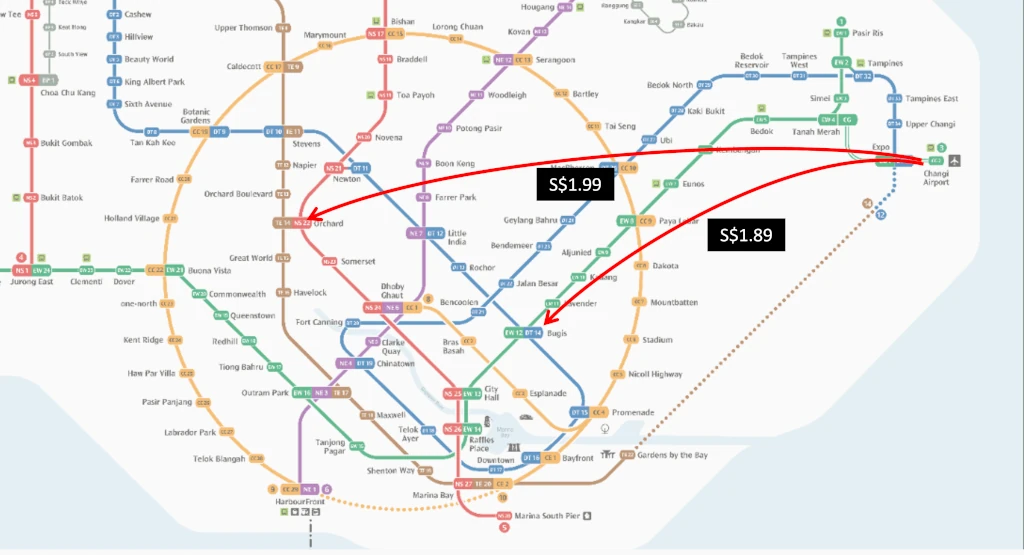How much a train ride costs in Singapore (visitor guide)
Singapore’s train network is massive. It stretches over 200km and has over 140 stations connecting most parts of the island. Most trains are capable of fully-automated operation, this means that they can run safely without a driver at all. Locals refer to the train as “MRT”, meaning Mass Rapid Transit, and I wrote this guide as part of a series I’m doing on making the MRT more accessible for visitors.
So how much does the MRT cost? The cheapest fare for an MRT journey is S$1.09 while the most expensive is S$2.37.26. The fare depends on how far you are travelling. Most visitors to Singapore can expect a single journey on the train to cost them between S$1.09 and S$2. The most convenient way to pay is by using a credit card to tap on and off at the fare gates.
Below are some of the journeys that visitors typically make and the associated fare:
| Journey | Fare |
|---|---|
| Changi Airport to Orchard Rd | S$2.20 |
| Changi Airport to Bugis | S$2.00 |
| Tanjong Pagar to Orchard Rd | S$1.19 |
| Orchard Rd to Bugis | S$1.19 |
| Bugis to Botanic Gardens | S$1.40 |
Train fares in Singapore are distanced based and start at S$0.99 for a single journey (including interchange). The fare increments by 10 cents every couple of kilometres and has a cap of S$2.26.

A journey can consist of interchange between two different train lines, or a train and a bus (it can also be between two different bus routes).
I’ve gone into further detail below about some of the common train journeys in Singapore, as well as what sort of ticket can be used. If you need a helpful map of the Singapore train network, check it out on LTA’s website here.
Tickets and Tourist Pass
The easiest way to pay for trains in Singapore is by using a credit card. Visa and Mastercard credit (or debit) cards can be used as contactless payment for train journeys in Singapore. Foreign credit cards will work if the foreign bank allows them to; there is a payment processing fee of 60 cents per day for foreign credit cards (if you take 1 journey, it’s 60 cents; if you take 5 journeys, it’s still 60 cents).
I recommend everyone use a Visa or Mastercard (preferably credit over debit) wherever possible for public transport in Singapore - even with the 60 cent fee it is much easier than worrying about prepaid balances and card costs (which are not refunded).
A prepaid EZ Link card can also be used to pay for train fares in Singapore:
- EZ Link can be purchased at train stations, including the airport
- Costs S$10 and comes with S$5 of credit
- Can also be purchased at convenience stores (e.g. 7/11) but they are allowed to charge more for the same S$5 of credit
There is a Singapore Tourist Pass offering UNLIMITED rides per day on Singapore public transport. It is expensive though costing roughly S$29 for three days of travel. This means that you have to ride the train (or bus) at least 4-5 times per day to make the tourist pass worth it. See References at the end of this article for more details on the Singapore Tourist Pass.
Cash cannot be used to pay for train tickets in Singapore.
Train FROM Changi Airport
Singapore Changi Airport is connected to the rest of Singapore by a branch of the East-West Line. Terminals 1, 2, and 3 are connected to the Changi Airport MRT station. Jewel is also easily accessible from the station. While Terminal 4 is not directly connected, it can be reached using a bus service from Terminal 2.
Expect to pay between S$1.50 and S$2.20 for train journeys from Changi Airport to the rest of Singapore. The train fare from Changi Airport is the same distance-based fare as the rest of the city, however due to Changi being further from the city, most visitors end up paying at least S$1.50 for their train ride.
Train TO Changi Airport
Changi Airport can similarly be accessed from any of the MRT stations throughout the city.
There is no additional fee for interchange, meaning that any station can be used to access the airport. Catching the train is usually the quickest and cheapest way to get to the airport - the only place I can think of where it is better for visitors to catch the bus is from the Katong / Marine Parade area (there are other areas but these are less frequented by visitors, such as Punggol and Tampines).
Skytrain at Changi
The Skytrain service at Changi Airport operating between Terminals 1, 2, and 3 is completely free. Like most airports in the world, Changi does not charge passengers to use its train service connecting between terminals.
Changi Airport’s Skytrain operates every 5-10 minutes for most hours of the day (it does not operate between 1:30am and 4:30am - it is still possible to walk between terminals at this time).
For more detail on how to connect between terminals at Changi Airport, check out their website here.
If you’re travelling around the far-flung reaches of Singapore you might discover a similar looking “light” train running around on viaducts in the city. The Changi Airport Skytrain is essentially the same as the Sengkang-Punggol LRT system, and they require a fare to be paid to ride.
Train to Malaysia
Apart from the MRT, you can also catch the train from Singapore to Malaysia.
The journey lasts 5 minutes, departing from the Woodlands train station in Singapore and terminating at the JB Sentral station in Johor. There is a passport and customs check before boarding and then again upon arrival into Malaysia. Make sure you turn up early at Woodlands to complete this check.
Catching the train to Malaysia costs 16 Malaysian ringgit (or roughly S$5 Singapore dollars). I recommend booking online in advance as the train is very popular, many services are completely sold out every weekend. Every seat is sold and there is no standing on-board the train. Online booking can be performed on the KTM website here.
A rapid transit train is coming soon, I will update this section when the service is available.
References
For more detail on the Singapore Tourist Pass, check out the their comparison here
If you need more help catching a train in Singapore, I made a whole video about using Singapore trains here:
I also wrote a full guide available here.

